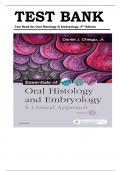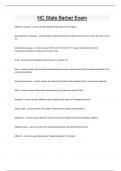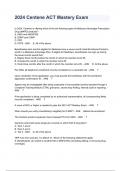TEST BANK
TE
Test Bank for Oral Histology & Embryology, 5th Edition
S
TB
A N
KS
O
LU
TI
O
N
S
, Daniel J. Chiego: Essentials of Oral Histology and Embryology-A Clinical
Approach
TE
Chapter 01: Development and Structure of Cells and Tissues
S
MULTIPLE CHOICE
TB
1. Mitochondria produce which chemical for intracellular energy?
a. ADP
b. ATP
c. RNA
d. DNA
A
ANS: B
N
Feedback
A Mitochondria generate energy through ATP, not ADP, production.
B Correct. Mitochondria produce energy via ATP.
KS
C Mitochondria generate energy through ATP, not RNA, production.
D Mitochondria generate energy through ATP, not DNA, production.
DIF: Recall REF: pp. 2-3 OBJ: 1
O
2. Each tissue originates from mesoderm, EXCEPT one. Which is the EXCEPTION?
a. Bone
LU
b. Liver
c. Blood
d. Muscle
ANS: B
TI
Feedback
A Bone tissue develops from mesodermal cells.
B Correct. Liver tissue is produced by endodermal cells.
O
C Blood develops from mesodermal cells.
D Muscle tissue develops from mesodermal cells.
N
DIF: Recall REF: p. 6 OBJ: 3
3. Which chemical is called the second messenger?
S
a. aDNA
b. mRNA
c. dGMP
, d. cAMP
ANS: D
TE
Feedback
A cAMP is the second messenger; aDNA is not.
B cAMP is the second messenger; mRNA is not.
C cAMP is the second messenger; dGMP is not.
S
D Correct. cAMP transmits information to the intracellular organelles when
activated by surface receptors on the plasma membrane.
TB
DIF: Recall REF: p. 3 OBJ: 3
4. Which cellular component facilitates protein synthesis?
a. Ribosomes
A
b. Lysosomes
c. Mitochondria
N
d. Plasmalemma ANS: A
Feedback
KS
A Correct. Ribosomes synthesize protein.
B Lysosomes facilitate the breakdown of intracellular and extracellular substances.
C Mitochondria generate energy.
D The plasmalemma provides a protective barrier and regulates the transport of
substances to and from the cell.
O
5. Which organelle produces microtubules?
LU
a. Nucleus
b. Centriole
c. Golgi apparatus
d. Endoplasmic reticulum ANS: B
TI
Feedback
A Centrioles generate microtubules; the nucleus does not.
B Correct. Centrioles produce microtubules.
O
C Centrioles generate microtubules; the Golgi apparatus does not.
D Centrioles generate microtubules; the endoplasmic reticulum does not.
N
DIF: Recall REF: p. 3 OBJ: 1
S
6. Which phase of the cell cycle is characterized as the initial resting stage?
, a. S phase
b. G1 phase
TE
c. G2 phase
d. Prophase ANS: B
Feedback
A The S phase is characterized as the stage in which DNA synthesis is complete.
S
B Correct. The G1 phase is the initial resting stage.
C The G2 phase is characterized by post-DNA duplication.
TB
D Prophase is characterized by four specific structural changes.
DIF: Recall REF: p. 4 OBJ: 1
7. Posttranslational modifications to proteins produced by the rough endoplasmic reticulum
A
are
accomplished by .
N
a. mitochondria
b. Golgi apparatus
c. messenger RNA
KS
d. smooth endoplasmic reticulum ANS: B
Feedback
A The Golgi apparatus is responsible for posttranslational alterations; mitochondria
are not.
O
B Correct. The Golgi apparatus makes alterations to proteins produced by the
rough endoplasmic reticulum.
LU
C The Golgi apparatus is responsible for posttranslational alterations; mRNA is
not.
D The Golgi apparatus is responsible for posttranslational alterations; the smooth
endoplasmic reticulum is not.
TI
DIF: Recall REF: p. 2 OBJ: 1
8. The provides an ideal environment for the implantation and growth of the embryo.
O
a. ovary
b. uterine tube
c. myometrium
N
d. endometrium ANS: D
S
Feedback
, A The ovary is the female reproductive organ, in which the ova or eggs are
produced.
TE
B The uterine tube conducts the egg from the ovary to the uterus.
C The myometrium is the smooth muscle that lines the uterus.
D Correct. The endometrium provides the ovum with the nourishment necessary
for implantation and growth.
S
9. Intercalated disks are present in which type of muscle?
a. Cardiac
TB
b. Smooth
c. Skeletal
d. Voluntary ANS: A
Feedback
A
A Correct. Cardiac is the only type of muscle tissue with intercalated disks.
B Intercalated disks are not present in smooth muscle.
N
C Intercalated disks are not present in skeletal muscle.
D Intercalated disks facilitate the involuntary contractions of cardiac muscle.
KS
DIF: Recall REF: p. 15 OBJ: 4
10. Developmental abnormalities are not associated with which number of chromosomes?
a. 44
b. 45
O
c. 46
d. 47
LU
ANS: C
Feedback
A Developmental abnormalities are associated with less than the normal number of
chromosomes (46).
TI
B Developmental abnormalities are associated with less than the normal number of
chromosomes (46).
C Correct. The normal human cell has 46 total chromosomes.
O
D Developmental abnormalities are associated with more than the normal number
of chromosomes (46).
N
DIF: Comprehension REF: p. 16 OBJ: 4
S
11. Which best describes diapedesis?
, a. Programmed cell death and fragmentation
b. A protective mechanism in the immunologic defense of the body
TE
c. The development of a cartilage disk in the neck of each long bone
d. The migration of leukocytes between endothelial cells to the site of infection ANS: D
Feedback
A Apoptosis is cell death and fragmentation into membrane-bound particles.
S
B The lymphatic system is an immunologic defense mechanism.
C The epiphyseal plate is a developmental disk of cartilage.
TB
D Correct. Diapedesis is a process whereby leukocytes migrate between
endothelial cells to the site of infection.
DIF: Comprehension REF: p. 12 OBJ: 4
A
12. T cells, B cells, NK cells, and macrophages are produced in the .
a. spleen
N
b. cerebellum
c. lymph nodes
d. bone marrow ANS: D
KS
Feedback
A Immune system cells (T cells, B cells, NK cells, and macrophages) are produced
in the bone marrow, not the spleen.
B Immune system cells (T cells, B cells, NK cells, and macrophages) are produced
O
in the bone marrow, not the cerebellum.
C Immune system cells (T cells, B cells, NK cells, and macrophages) are produced
LU
in the bone marrow, not the lymph nodes.
D Correct. Bone marrow is the site of formation for T cells, B cells,
NK cells, and macrophages.
13. Which represent the first change in shape of the embryo’s body from a flat sheet of cells?
TI
a. Formation of the embryonic disk.
b. Formation of neural folds.
c. Formation of cartilage.
O
d. Migration of myoblasts from the myotome. ANS: B
Feedback
N
A The embryonic disk forms from a small inner cell mass within the blastocyst. This occurs
prior to the formation of the three primordial layers, long before the
S
embryo acquires a three-dimensional shape.
, B Correct. The neural folds can be seen during the third prenatal week.
The lateral
TE
edges of the neural plate begin to elevate as folds arise dorsally.
C Cartilage first appears in the fifth week.
D Muscle cells have begun migrating from the myotome by the 10th prenatal
week.
S
DIF: Comprehension REF: pp. 10-11 OBJ: 3
TB
14. Myotome produces which of the following types of tissue?
a. Connective
b. Muscle
c. Nerve
d. Epithelial ANS: B
A
Feedback
N
A Connective tissue develops from somites as fibroblasts migrating from either
side of the neural tube.
B Correct. Myoblasts have begun migrating from the myotome by the 10th
KS
prenatal week. They gradually differentiate into elongated, multinucleatedmuscle fibers.
C Nerve is derived from both the cranial and trunk neural crest. When the anterior
neural tube closes, it shows three dilations that form the primary brain vesicles.
D Skin has an epidermis, a surface cell layer that develops from the surface of
ectodermal cells, and a dermis, which arises from the underlying mesoderm.
O
DIF: Comprehension REF: p. 15 OBJ: 3
LU
15. Which type of bone formation occurs through a tight matrix of collagen fibers, which
slowly calcify into bone?
a. Endochondral
b. Intramembranous
TI
c. Epiphyseal
d. Interstitial growth ANS: B
O
Feedback
A Bone replaces cartilage during endochondral bone development. A small bloodvessel
enters the cartilage shaft, the cartilage calcifies and disintegrates in the
N
center, and a marrow space is formed.
S
, Oral Histology and Embryology 5th edition Chiego 8
B Correct. Intramembranous bone formation is the direct transformation of connective
tissue into bone. It is much simpler for bone cells to organize in thismanner and to form spicules
TE
of bone through coalescence with neighboring
spicules until a bony plate is formed.
C The epiphyseal plate is a developing cartilage disk that remains in the neck of
each long bone and bone forms on either side. It will remain as long as the boneis forming.
D Cartilage develops and expands by interstitial growth, which is growth within the
S
cartilage matrix by each cartilage cell enlarging and forming matrix around
each cell.
TB
16. Blood cells arise from cells called
a. neuroblasts.
b. fibroblasts.
c. osteoblasts.
A
d. angioblasts. ANS: D
N
Feedback
A Neuroblasts are primitive nerve cells that develop into adult neurons.
B Connective tissue develops from the somites as fibroblasts migrating from either
KS
side of the neural tube.
C Osteoblasts will form bone.
D Correct. The cardiovascular system originates from cells termed angioblasts, which arise
from angiogenic clusters from the visceral mesoderm located in the walls of the yolk sac during
the third week.
O
The outer cells organize into a series
of elongating tubes and the inner cells become blood cells.
LU
DIF: Recall REF: p. 15 OBJ: 3
17. Each of the following is a derivative of ectoderm EXCEPT one. Which is the
EXCEPTION?
TI
a. Tooth enamel
b. Tooth dentin
c. Epidermis
O
d. Nervous system ANS: B
Feedback
N
A Tooth enamel is derived from ectoderm.
B Correct. Tooth dentin is derived from mesoderm. Muscle and connective tissue
S
derivatives such as: bone, cartilage, blood, pulp, cementum, and the
Test Bank Page 8
, Oral Histology and Embryology 5th edition Chiego 9
periodontalligament are also derived from mesoderm.
C The epidermis, hair, and nails are derived from ectoderm.
TE
D The nervous system, sensory epithelium of the eye, ear, and nose, and
epithelium of the sinuses, oral and nasal cavities, and intraoral
glands are allderived from epithelium.
DIF: Comprehension REF: p. 9 OBJ: 3
S
18. Which hormone is produced by the placenta?
TB
a. Follicle-stimulating hormone (FSH)
b. Prolactin
c. Progesterone
d. Adrenocorticotropic hormone (ACTH) ANS: C
A
Feedback
A Follicle-stimulating hormone (FSH) is secreted by the anterior lobe of the
N
pituitary gland.
B Prolactin is produced by the anterior lobe of the pituitary gland.
C Correct. The placenta produces hormones such as human chorionic gonadotropin,
KS
placental growth factor, human placental lactogen,
andprogesterone and estrogen.
D Adrenocorticotropic hormone (ACTH) is produced by the anterior lobe of the
pituitary gland.
O
DIF: Comprehension REF: p. 16 OBJ: 4
LU
TRUE/FALSE
1. The ovum contains twice as many chromosomes as its parent cell.
ANS: F DIF: Comprehension REF: p. 4OBJ: 1
TI
2. The cell may contain more than one nucleolus.
O
ANS: T DIF: Recall REF: p. 2 OBJ: 1
3. The information in mRNA is translated by ribosomes located on the surface of the rough
N
endoplasmic reticulum.
S
ANS: T DIF: Comprehension REF: p. 2OBJ: 1
Test Bank Page 9






